2004 GMC SIERRA Rear
[x] Cancel search: RearPage 1 of 588

Seats and Restraint Systems........................... 1-1
Front Seats
............................................... 1-3
Rear Seats
............................................... 1-9
Safety Belts
.............................................1-11
Child Restraints
.......................................1-33
Air Bag Systems
......................................1-70
Restraint System Check
............................1-87
Features and Controls..................................... 2-1
Keys
........................................................ 2-3
Doors and Locks
....................................... 2-8
Windows
.................................................2-16
Theft-Deterrent Systems
............................2-19
Starting and Operating Your Vehicle
...........2-21
Mirrors
....................................................2-54
OnStar
žSystem
......................................2-64
Storage Areas
.........................................2-66
Vehicle Personalization
.............................2-69
Instrument Panel............................................. 3-1
Instrument Panel Overview
.......................... 3-4
Climate Controls
......................................3-21
Warning Lights, Gages and Indicators
.........3-33
Driver Information Center (DIC)
..................3-55
Audio System(s)
.......................................3-73Driving Your Vehicle....................................... 4-1
Your Driving, the Road, and Your Vehicle
..... 4-2
Towing
...................................................4-53
Service and Appearance Care.......................... 5-1
Service
..................................................... 5-3
Fuel
......................................................... 5-4
Checking Things Under the Hood
...............5-10
Rear Axle
...............................................5-59
Four-Wheel Drive
.....................................5-60
Noise Control System
...............................5-62
Bulb Replacement
....................................5-64
Windshield Wiper Blade Replacement
.........5-74
Tires
......................................................5-76
Appearance Care
...................................5-116
Vehicle Identi®cation
...............................5-125
Electrical System
....................................5-125
Capacities and Speci®cations
...................5-134
Maintenance Schedule..................................... 6-1
Maintenance Schedule
................................ 6-2
Customer Assistance and Information.............. 7-1
Customer Assistance and Information
........... 7-2
Reporting Safety Defects
...........................7-11
Index................................................................ 1
2004 GMC Sierra Owner ManualM
Page 7 of 588
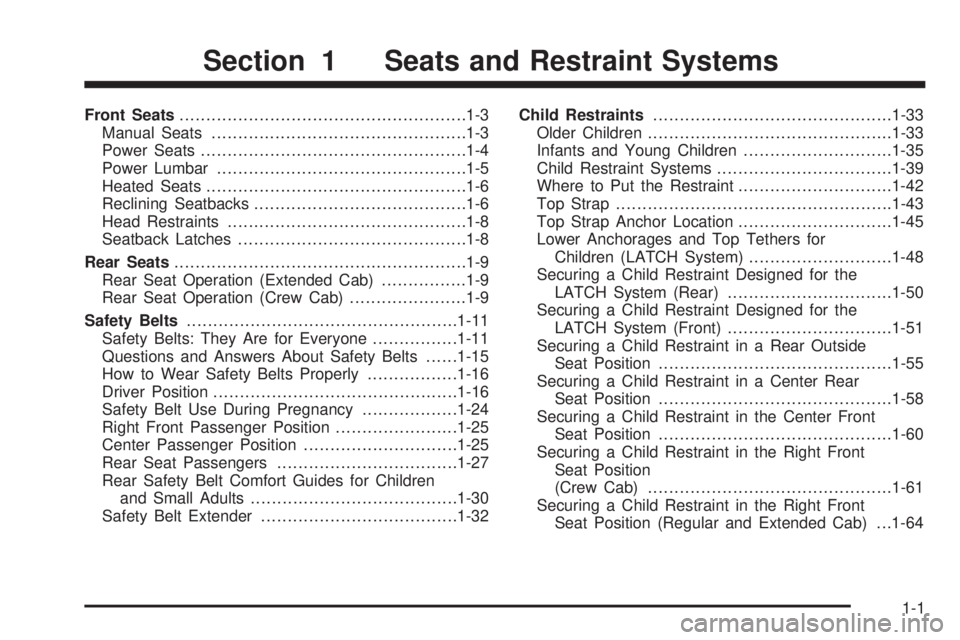
Front Seats......................................................1-3
Manual Seats................................................1-3
Power Seats..................................................1-4
Power Lumbar...............................................1-5
Heated Seats.................................................1-6
Reclining Seatbacks........................................1-6
Head Restraints.............................................1-8
Seatback Latches...........................................1-8
Rear Seats.......................................................1-9
Rear Seat Operation (Extended Cab)................1-9
Rear Seat Operation (Crew Cab)......................1-9
Safety Belts...................................................1-11
Safety Belts: They Are for Everyone................1-11
Questions and Answers About Safety Belts......1-15
How to Wear Safety Belts Properly.................1-16
Driver Position..............................................1-16
Safety Belt Use During Pregnancy..................1-24
Right Front Passenger Position.......................1-25
Center Passenger Position.............................1-25
Rear Seat Passengers..................................1-27
Rear Safety Belt Comfort Guides for Children
and Small Adults.......................................1-30
Safety Belt Extender.....................................1-32Child Restraints.............................................1-33
Older Children..............................................1-33
Infants and Young Children............................1-35
Child Restraint Systems.................................1-39
Where to Put the Restraint.............................1-42
Top Strap....................................................1-43
Top Strap Anchor Location.............................1-45
Lower Anchorages and Top Tethers for
Children (LATCH System)...........................1-48
Securing a Child Restraint Designed for the
LATCH System (Rear)...............................1-50
Securing a Child Restraint Designed for the
LATCH System (Front)...............................1-51
Securing a Child Restraint in a Rear Outside
Seat Position............................................1-55
Securing a Child Restraint in a Center Rear
Seat Position............................................1-58
Securing a Child Restraint in the Center Front
Seat Position............................................1-60
Securing a Child Restraint in the Right Front
Seat Position
(Crew Cab)..............................................1-61
Securing a Child Restraint in the Right Front
Seat Position (Regular and Extended Cab) . . .1-64
Section 1 Seats and Restraint Systems
1-1
Page 10 of 588
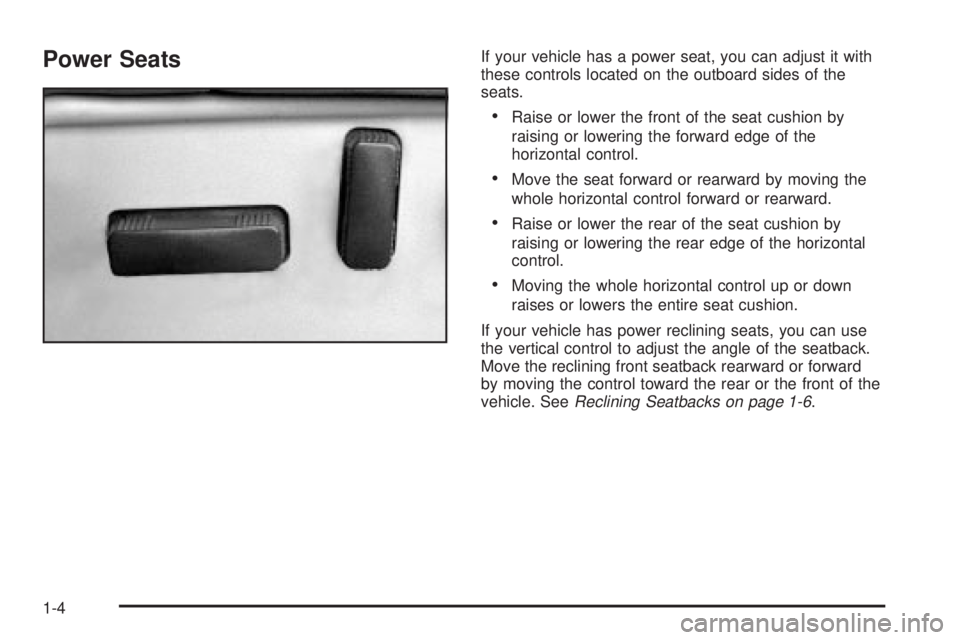
Power SeatsIf your vehicle has a power seat, you can adjust it with
these controls located on the outboard sides of the
seats.
·Raise or lower the front of the seat cushion by
raising or lowering the forward edge of the
horizontal control.
·Move the seat forward or rearward by moving the
whole horizontal control forward or rearward.
·Raise or lower the rear of the seat cushion by
raising or lowering the rear edge of the horizontal
control.
·Moving the whole horizontal control up or down
raises or lowers the entire seat cushion.
If your vehicle has power reclining seats, you can use
the vertical control to adjust the angle of the seatback.
Move the reclining front seatback rearward or forward
by moving the control toward the rear or the front of the
vehicle. See
Reclining Seatbacks on page 1-6.
1-4
Page 11 of 588
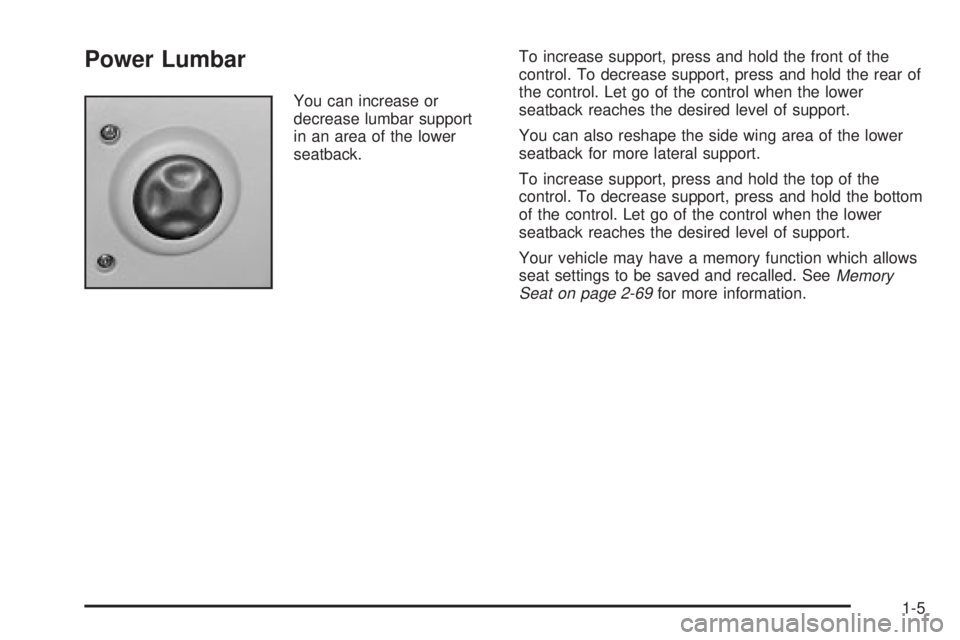
Power Lumbar
You can increase or
decrease lumbar support
in an area of the lower
seatback.To increase support, press and hold the front of the
control. To decrease support, press and hold the rear of
the control. Let go of the control when the lower
seatback reaches the desired level of support.
You can also reshape the side wing area of the lower
seatback for more lateral support.
To increase support, press and hold the top of the
control. To decrease support, press and hold the bottom
of the control. Let go of the control when the lower
seatback reaches the desired level of support.
Your vehicle may have a memory function which allows
seat settings to be saved and recalled. See
Memory
Seat on page 2-69for more information.
1-5
Page 14 of 588

Head Restraints
Adjust your head restraint so that the top of the restraint
is closest to the top of your head. This position
reduces the chance of a neck injury in a crash.
To raise the head restraint pull up on the head restraint.
On some models the head restraints tilt forward and
rearward also.The rear seat head restraints in your vehicle may be
adjustable. They work the same as the front seat head
restraints, except they do not tilt forward and rearward.
Seatback Latches
{CAUTION:
If the seatback isn't locked, it could move
forward in a sudden stop or crash. That could
cause injury to the person sitting there. Always
press rearward on the seatback to be sure it is
locked.
The seatbacks fold forward to let you access the rear of
the cab.
To fold a front seatback forward, lift the lever at the
base of the seat to release the seatback.
The lever is located on the outboard side of the seat
cushion.
To return the seatback to the upright position, push the
seatback rearward until it latches. After returning the
seatback to its upright position, push and pull on
the seatback to make sure it is locked.
1-8
Page 15 of 588
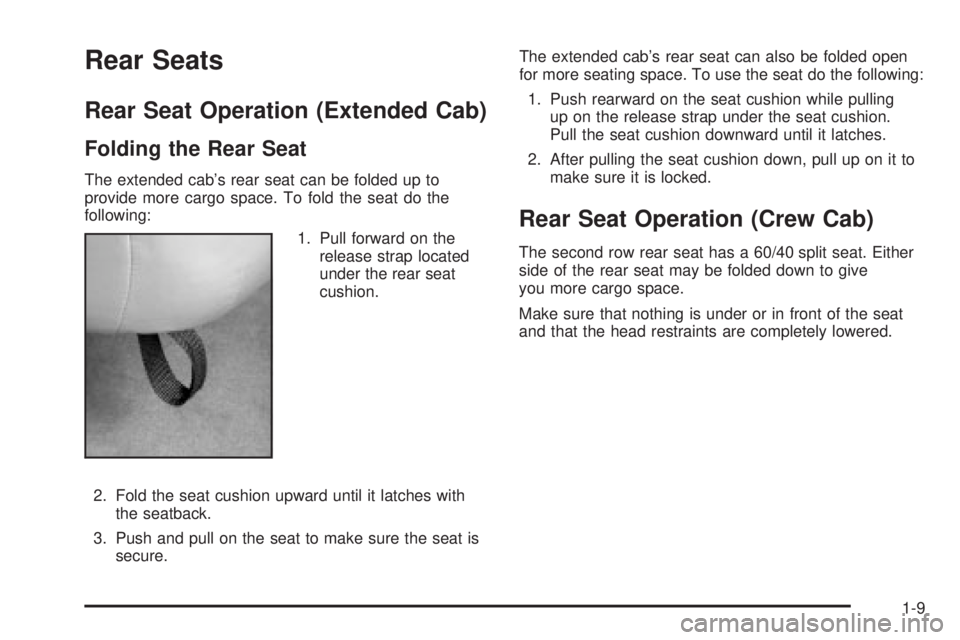
Rear Seats
Rear Seat Operation (Extended Cab)
Folding the Rear Seat
The extended cab's rear seat can be folded up to
provide more cargo space. To fold the seat do the
following:
1. Pull forward on the
release strap located
under the rear seat
cushion.
2. Fold the seat cushion upward until it latches with
the seatback.
3. Push and pull on the seat to make sure the seat is
secure.The extended cab's rear seat can also be folded open
for more seating space. To use the seat do the following:
1. Push rearward on the seat cushion while pulling
up on the release strap under the seat cushion.
Pull the seat cushion downward until it latches.
2. After pulling the seat cushion down, pull up on it to
make sure it is locked.
Rear Seat Operation (Crew Cab)
The second row rear seat has a 60/40 split seat. Either
side of the rear seat may be folded down to give
you more cargo space.
Make sure that nothing is under or in front of the seat
and that the head restraints are completely lowered.
1-9
Page 16 of 588
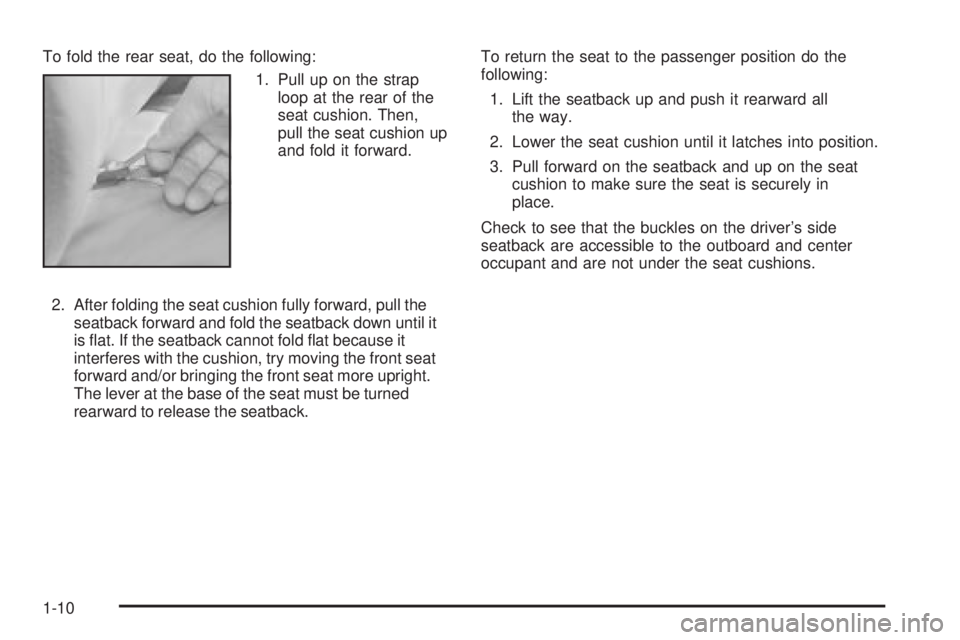
To fold the rear seat, do the following:
1. Pull up on the strap
loop at the rear of the
seat cushion. Then,
pull the seat cushion up
and fold it forward.
2. After folding the seat cushion fully forward, pull the
seatback forward and fold the seatback down until it
is ¯at. If the seatback cannot fold ¯at because it
interferes with the cushion, try moving the front seat
forward and/or bringing the front seat more upright.
The lever at the base of the seat must be turned
rearward to release the seatback.To return the seat to the passenger position do the
following:
1. Lift the seatback up and push it rearward all
the way.
2. Lower the seat cushion until it latches into position.
3. Pull forward on the seatback and up on the seat
cushion to make sure the seat is securely in
place.
Check to see that the buckles on the driver's side
seatback are accessible to the outboard and center
occupant and are not under the seat cushions.
1-10
Page 31 of 588
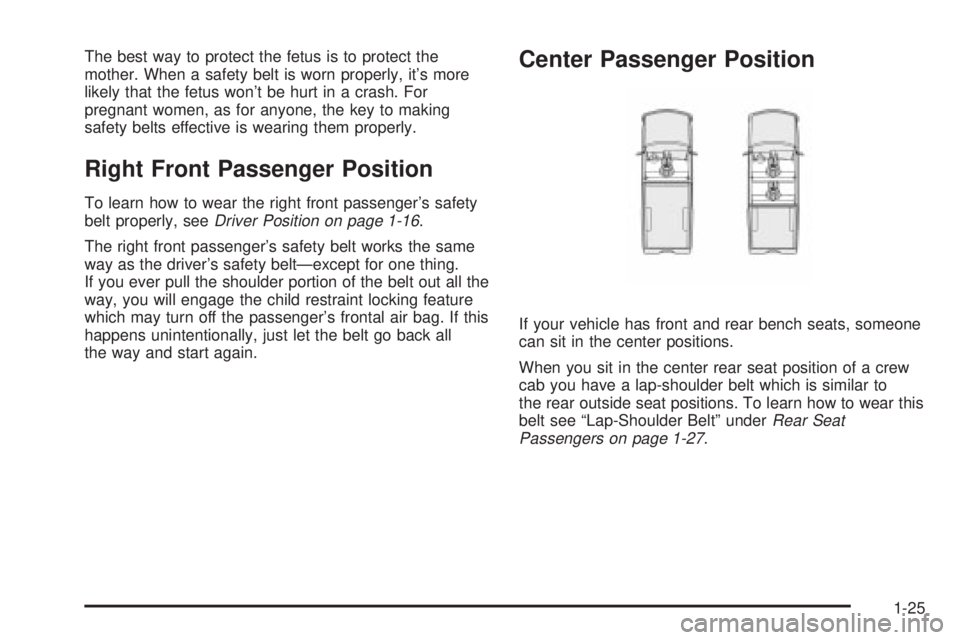
The best way to protect the fetus is to protect the
mother. When a safety belt is worn properly, it's more
likely that the fetus won't be hurt in a crash. For
pregnant women, as for anyone, the key to making
safety belts effective is wearing them properly.
Right Front Passenger Position
To learn how to wear the right front passenger's safety
belt properly, seeDriver Position on page 1-16.
The right front passenger's safety belt works the same
way as the driver's safety beltÐexcept for one thing.
If you ever pull the shoulder portion of the belt out all the
way, you will engage the child restraint locking feature
which may turn off the passenger's frontal air bag. If this
happens unintentionally, just let the belt go back all
the way and start again.
Center Passenger Position
If your vehicle has front and rear bench seats, someone
can sit in the center positions.
When you sit in the center rear seat position of a crew
cab you have a lap-shoulder belt which is similar to
the rear outside seat positions. To learn how to wear this
belt see ªLap-Shoulder Beltº under
Rear Seat
Passengers on page 1-27.
1-25